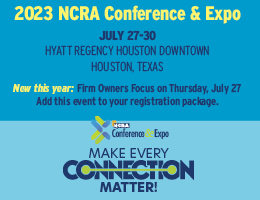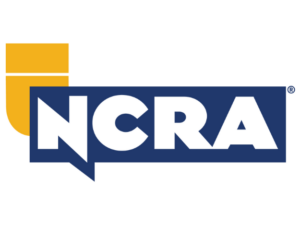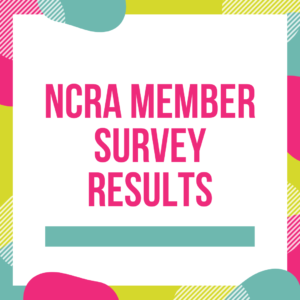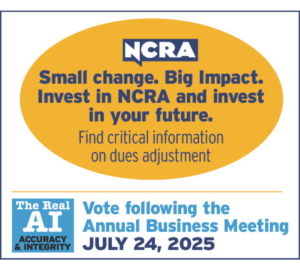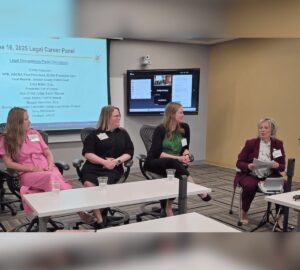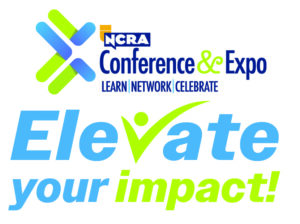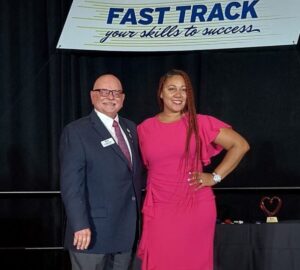On the occasion of Stenograph’s seventy-fifth anniversary, Jim Cudahy, NCRA’s executive director and CEO, took the opportunity to talk to John Wenclawski, Stenograph’s president. Here are some highlights of the company’s history from the interview.
Jim Cudahy: Congratulations. Seventy-five years is quite a long time. Can you tell us how the company was founded and what it was like at the beginning?
John Wenclawski: Well, nobody who was around 75 years ago is still here, and nobody did a real good job creating a record. M.H. Wright founded the company in 1938 in Chicago. Back then, the company was selling machines for $45 or $65, and they sold about 4,000 machines annually. But when the United States entered World War II in Sept. 1939, the government came in and took over the factory, and it slowed the production of machines. Plus, there wasn’t a demand for stenographers or machines during the war.
When World War II ended, production of the machines started up again, and sales soared. It was also about this time, in 1948, that the person who’s most associated with the company’s success came into the picture — Bob Wright. Bob took over the company in the 1950s, and he ran the company until it was sold in 1978.
Here’s something most people aren’t aware of: In the 1940s, ’50s, and ’60s, it was a much smaller company as you would anticipate, and half of the company’s revenue was from non-stenographic applications. We did some really interesting things that we found in the archives.
Cudahy: What kinds of things was the company doing?
Wenclawski: I could say about 50 percent of our revenue came from government sales. We were making little “encoders,” basically little devices that you could input a message in. There was a code, so the actual letters that were coming out were not the letters you typed in. It was getting put on a magnetic tape, which in the 1950s nobody was using tape yet. Today, it’s old, but back then, tape wasn’t even being used. These were all handmade devices that would get buried behind enemy lines to communicate critical information. Then the tape would be put it into a decoder for the message to get translated. Stenograph produced a number of variations of these devices.
Cudahy: It probably started with the Army but also the CIA.
Wenclawski: Army, CIA, all these domestic and international groups. The thing was, back in those days, it was all done by hand.
In the 1960s, we were selling 15,000 to 17,000 machines. That is a lot more than we sell today. Back then, shorthand was being taught in the high schools — not for court reporting but for secretarial applications.
Cudahy: What have you seen as the biggest changes that have occurred in the profession since you’ve been involved with Stenograph?
Wenclawski: When I came to work at Steno graph in 1983, CAT was a concept that people didn’t think would work. They didn’t think it was a viable alternative to typing or dictating. It was a concept that you had to sell people on, to educate people on. To see what has happened with technology and CAT software is just amazing. The machines we sold then had a data cassette, and an eight-inch floppy disk in the computer, which weighed 100 pounds. We thought those computers were so fast back then; but today the systems can process 50 times faster. If the computer would translate 250 pages an hour, we thought that was good. Today, everything is instantaneous.
We had no idea the technology would move as fast as it did. We really believed that those computers were going to last 10 or 20 years. But the computer business now just moves so quickly. Everything’s faster, smaller, and less expensive.
Cudahy: What do you like most about the court reporting profession?
Wenclawski: You meet a lot of really nice people in the community. Generally, they’re honest people, they’re respectful, and many are very appreciative. I see the relationships with court reporters that have developed into friendships and you see them walking around giving each other hugs during conventions. People really mix business and pleasure.
Cudahy: Let’s take a step back and ask you some more specifics about Stenograph.
Wenclawski: We talked a little bit about some of the alternative products Stenograph worked on for government intelligence back in the 1960s. We also did a program with the government translating Russian newspapers during the Cold War. We came up with using a stenographer and some software we developed to translate the Russian papers to English. Also in the 1960s, we developed the first CAT system in conjunction with IBM. The computer took up the whole room. It was a service center application. People would send in their steno notes, we would translate the notes, and they’d get a big stack of green bar paper to proof. Not very successful, but it was our first attempt at CAT.
Cudahy: What’s something about Stenograph that people don’t know and they should?
Wenclawski: Many people think we’re bigger than we are: We have 150 employees, many of whom have been with us more than 20 years, and they’ve been with us because they really care about the company, and they care about the customers. There’s really a positive customer service attitude within the organization.
Another thing is that I don’t think people realize or appreciate the technology that we’ve developed over the years — everything from the machine to the software. I don’t think we get the credit that we deserve when it comes to technology.
Cudahy: What’s really the core of your business these days?
Wenclawski:We always look at our business in three sectors: The machine sector is primarily the professional machine today, it is the biggest piece of our business, and it’s driven by the Diamante. Software business is very important but because so many people have a CAT system and don’t want to go through the process of changing CAT systems, software in general is down slightly. But it’s still a very good piece of the business especially with the support part of it. The school part of the business is our third sector.
Cudahy: Tell us why Stenograph got into the school business.
Wenclawski: We were very reluctant to get into the school business because a fair percentage of our business came from the schools, but at the same time, we had customers — both the school owners as well as reporters — reaching out to us to say, “You need to get involved because the school market is going down.” Schools were closing on a regular basis, and they needed someone to come in who understood the schools, who had a commitment to the schools, and who really would show a commitment to the profession for the future of the profession. At the same time, we thought education in general would be a good business opportunity, and that’s why we got into it. It’s been a challenge.
Cudahy: What’s the stenographic court reporting profession going to look like 25 years from now? How might it be different?
Wenclawski: Over the past 20 years, the Stenograph machine development has really paralleled the evolution of notebook computers. We have a $2 million R&D budget on an annualized basis, but we cannot compete with the Apples and Dells of the world. We have to take their ideas and quickly bring it into our future development.
The primary request from the court reporter focus groups we have done has not changed. They want a machine that is lighter weight. They want a machine that has got better battery technology and helps in improving their writing. I think every generation of machine that we’ve introduced has included improvements in those areas. As far as the profession itself, I believe that it will not be as tied to its traditional legal roots. Legal work may continue to be the backbone, but there’ll be more nontraditional jobs. The future of the court reporting profession is taking the spoken word and creating an immediate useful, searchable text document, and that doesn’t necessarily have to be in the legal world. It can be over the Internet. It can be educationally oriented. There are all sorts of applications, and what’s going to make the profession successful is thinking outside the box, utilizing the unique skills, the realtime, and the technology that’s available. That’s the future.
As young attorneys come on board, they’re going to want that text fast. It’s a “now” society; everybody wants instant gratification, like our mobile devices. They’re going to want it everywhere, all the time. You’ve got to embrace the technology. It’s got to be realtime. If you do that, I think the demand for the service just goes up.
Cudahy: What keeps you up at night as the president of Stenograph?
Wenclawski: The future, there’s no question about it. When my day comes in the not-too-distant future, when I hope to retire someday, I would like to be able to hand over a thriving growth company.
That concerns me because I’m not sure where the profession is going at times. We don’t have new people coming in. We don’t have people embracing technology in their workplace, but the average person won’t keep a flat screen TV, cell phone, or cars — anything related to technology — that’s more than five years old. Yet a reporter will use a shorthand machine that might be well over 10 years old. Court reporters should be computer savvy, because that is their lifeline to making money. They should really know their software because there’s so much that the software products can do that would save them time. They’d be more efficient, and if you’re more efficient, either you can be making more money or enjoying life or both. I say that a lot of professions are experiencing these same challenges because we are really at a point where the profession is evolving. It’s going to be different in the future.
It’s important that you embrace technology because how you market yourself is important. Here’s a for-instance: I had dinner with an attorney a couple of weeks ago. He mentioned that he worked with this court reporter a week ago who had a really sleek-looking machine, which happened to be pink. He just kept going on and on about this machine. It made an impression on the attorney. By having the latest technology, that court reporter is going to improve how attorneys see her. She obviously did a good job, but in his eyes, she probably didn’t do that much better than others. But her use of technology, bringing that machine that was so sleek, made her stand out.
When you go out there with a 20-year old machine, it does not send a good signal about the profession. People think it’s antiquated. But if you go out there and throw iPads in front of them and use a nice machine and have a notebook computer and the realtime’s going, that’s impressive. Even if they don’t use it, they’re going to say, “This person has got her act together.”
That’s what keeps me up at night. How do we get reporters to embrace that stuff? Some do, but not enough.
Cudahy: Looking back on the 75 years of the company’s existence, what do you think is Stenograph’s legacy?
Wenclawski: I really believe that we’ve been the rock in supporting the court reporting profession. Throughout that time, we’ve developed and been the primary manufacturer of the instrument that is the backbone of the profession, the shorthand machine. In addition to that, we’ve continued to develop technology, in essence to push competition and the marketplace. With the court reporting profession, I’d like to think we’ve had a partnership that has allowed Stenograph to prosper for 75 years, and I think it’s really helped the court reporting profession prosper. Without each other, we would be in trouble. If we didn’t have court reporters embracing technology, embracing CAT, continuing to go to court reporting school, we’d be out of business.
Not many companies can say that they’ve been in business 75 years, and especially in the last 17 years that I’ve been president — we’ve been in a very solid financial position because of the partnership. I think it goes both ways. We’ve been able to give quality products and quality service that have allowed the reporters to make it easy to invest in us. We’re in this together.
Cudahy: How would you finish this sentence: Stenograph exists at its 150th anniversary if …
Wenclawski: If we find a way to truly exercise and participate in our core philosophy of being the purveyor of technology to take the spoken word and allow realtime access to the spoken word across the board. We have to build on our foundation in the court reporting business and expand beyond that as a technology supplier.
Cudahy: Thanks for talking with me, John. It’s been a pleasure to hear more about the business.
Wenclawski: Thank you, Jim.



